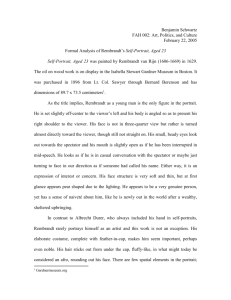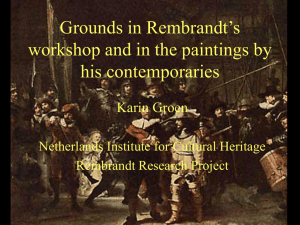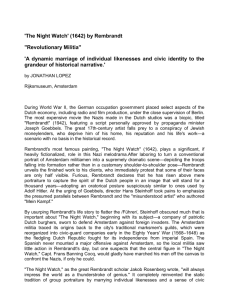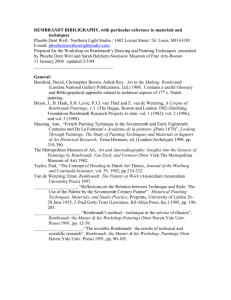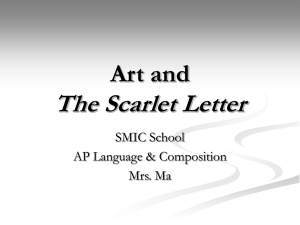Artist's Mother - Museum of Fine Arts
advertisement
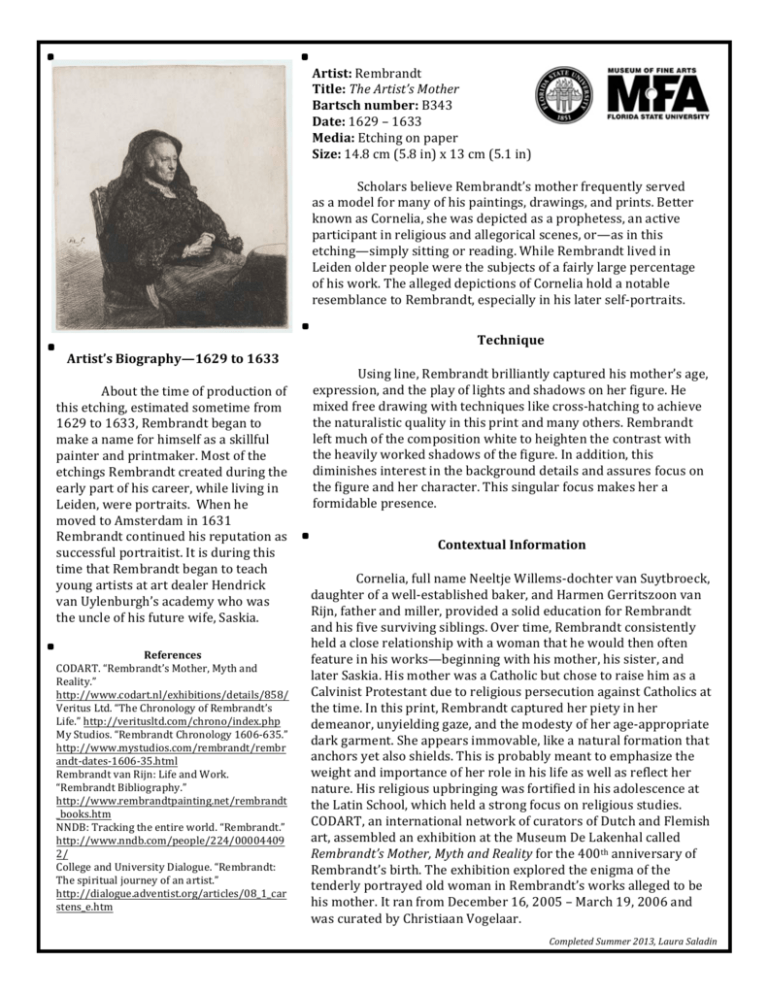
Artist: Rembrandt Title: The Artist’s Mother Bartsch number: B343 Date: 1629 – 1633 Media: Etching on paper Size: 14.8 cm (5.8 in) x 13 cm (5.1 in) Scholars believe Rembrandt’s mother frequently served as a model for many of his paintings, drawings, and prints. Better known as Cornelia, she was depicted as a prophetess, an active participant in religious and allegorical scenes, or—as in this etching—simply sitting or reading. While Rembrandt lived in Leiden older people were the subjects of a fairly large percentage of his work. The alleged depictions of Cornelia hold a notable resemblance to Rembrandt, especially in his later self-­‐portraits. Technique Artist’s Biography—1629 to 1633 About the time of production of this etching, estimated sometime from 1629 to 1633, Rembrandt began to make a name for himself as a skillful painter and printmaker. Most of the etchings Rembrandt created during the early part of his career, while living in Leiden, were portraits. When he moved to Amsterdam in 1631 Rembrandt continued his reputation as successful portraitist. It is during this time that Rembrandt began to teach young artists at art dealer Hendrick van Uylenburgh’s academy who was the uncle of his future wife, Saskia. References CODART. “Rembrandt’s Mother, Myth and Reality.” http://www.codart.nl/exhibitions/details/858/ Veritus Ltd. “The Chronology of Rembrandt’s Life.” http://veritusltd.com/chrono/index.php My Studios. “Rembrandt Chronology 1606-­‐635.” http://www.mystudios.com/rembrandt/rembr andt-­‐dates-­‐1606-­‐35.html Rembrandt van Rijn: Life and Work. “Rembrandt Bibliography.” http://www.rembrandtpainting.net/rembrandt _books.htm NNDB: Tracking the entire world. “Rembrandt.” http://www.nndb.com/people/224/00004409 2/ College and University Dialogue. “Rembrandt: The spiritual journey of an artist.” http://dialogue.adventist.org/articles/08_1_car stens_e.htm Using line, Rembrandt brilliantly captured his mother’s age, expression, and the play of lights and shadows on her figure. He mixed free drawing with techniques like cross-­‐hatching to achieve the naturalistic quality in this print and many others. Rembrandt left much of the composition white to heighten the contrast with the heavily worked shadows of the figure. In addition, this diminishes interest in the background details and assures focus on the figure and her character. This singular focus makes her a formidable presence. Contextual Information Cornelia, full name Neeltje W illems-­‐dochter van Suytbroeck, daughter of a well-­‐established baker, and Harmen Gerritszoon van Rijn, father and miller, provided a solid education for Rembrandt and his five surviving siblings. Over time, Rembrandt consistently held a close relationship with a woman that he would then often feature in his works—beginning with his mother, his sister, and later Saskia. His m other was a Catholic but chose to raise him as a Calvinist Protestant due to religious persecution against Catholics at the time. In this print, Rembrandt captured her piety in her demeanor, unyielding gaze, and the m odesty of her age-­‐appropriate dark garment. She appears immovable, like a natural formation that anchors yet also shields. This is probably meant to emphasize the weight and importance of her role in his life as well as reflect her nature. His religious upbringing was fortified in his adolescence at the Latin School, which held a strong focus on religious studies. CODART, an international network of curators of Dutch and Flemish art, assembled an exhibition at the Museum De Lakenhal called Rembrandt’s Mother, Myth and Reality for the 400th anniversary of Rembrandt’s birth. The exhibition explored the enigma of the tenderly portrayed old woman in Rembrandt’s works alleged to be his mother. It ran from December 16, 2005 – March 19, 2006 and was curated by Christiaan Vogelaar. Completed Summer 2013, Laura Saladin
